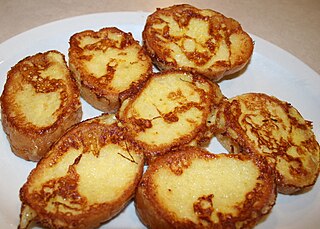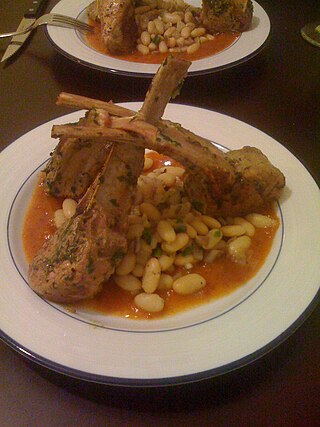 Melba toast topped with goat cheese and tomato jam | |
| Alternative names | Tomato jelly |
|---|---|
| Type | Fruit preserves |
| Main ingredients |
|
Tomato jam (or tomato jelly) [1] is a type of fruit preserve prepared with tomatoes and sugar. [2]
 Melba toast topped with goat cheese and tomato jam | |
| Alternative names | Tomato jelly |
|---|---|
| Type | Fruit preserves |
| Main ingredients |
|
Tomato jam (or tomato jelly) [1] is a type of fruit preserve prepared with tomatoes and sugar. [2]
Green tomatoes are used in some preparations. [1] [3] Some preparations may use honey, [4] and some include bacon. [5] It has been described as "a cross between marmalade and ketchup". [6] Some commercially prepared varieties are produced. It is sometimes used in the preparation of sandwiches similar to a BLT, using the jam in place of tomato. [7]
Tomato jam has been described as a popular condiment in South Africa. [8]
In 1840 in the United States, a recipe was published in the American Farmer that involved straining stewed tomatoes through cloth, adding an equal amount of sugar, and then boiling the mixture for a few hours. [1]
In 1843 in the U.S., a recipe for preparing tomato jam was published in the Boston Cultivator. [1] The preparation process included rubbing stewed tomatoes through a sieve, adding an equal amount of sugar, and then stewing the mixture into a jam. [1]

The cuisine of the Southern United States encompasses diverse food traditions of several subregions, including Tidewater, Appalachian, Lowcountry, Cajun, Creole, and Floribbean cuisine. In recent history, elements of Southern cuisine have spread to other parts of the United States, influencing other types of American cuisine.

Chowder is a thick soup prepared with milk or cream, a roux, and seafood or vegetables. Oyster crackers or saltines may accompany chowders as a side item, and cracker pieces may be dropped atop the dish. New England clam chowder is typically made with chopped clams and diced potatoes, in a mixed cream and milk base, often with a small amount of butter. Other common chowders include seafood chowder, which often consists of fish, clams, and other types of shellfish; lamb or veal chowder made with barley; corn chowder, which uses corn instead of clams; various fish chowders; and potato chowder, which is often made with cheese. Fish, corn, and clam chowders are popular in North America, especially New England and Atlantic Canada.

Ketchup or catsup is a table condiment with a sweet and sour flavor. The unmodified term ("ketchup") now typically refers to tomato ketchup, although early recipes used egg whites, mushrooms, oysters, grapes, mussels, or walnuts, among other ingredients.

French toast is a dish of sliced bread soaked in beaten eggs and often milk or cream, then pan fried. Alternative names and variants include "eggy bread", "Bombay toast", "gypsy toast", and "poor knights".

A chutney is a spread typically associated with cuisines of the Indian subcontinent. Chutneys are made in a wide variety of forms, such as a tomato relish, a ground peanut garnish, yogurt or curd, cucumber, spicy coconut, spicy onion or mint dipping sauce.

Meatloaf is a dish of ground meat that has been combined with other ingredients and formed into the shape of a loaf, then baked or smoked. The final shape is either hand-formed on a baking tray, or pan-formed by cooking it in a loaf pan. It is usually made with ground beef, although ground lamb, pork, veal, venison, poultry, and seafood are also used, sometimes in combination. Vegetarian adaptations of meatloaf may use imitation meat or pulses.
Sweet and sour is a generic term that encompasses many styles of sauce, cuisine and cooking methods. It is commonly used in East Asia and Southeast Asia, and has been used in England since the Middle Ages. Sweet and sour sauce remains popular in Asian and Western cuisines.

South African cuisine reflects the diverse range of culinary traditions embodied by the various communities that inhabit the country. Among the indigenous peoples of South Africa, the Khoisan foraged over 300 species of edible food plants, such as the rooibos shrub legume, whose culinary value continues to exert a salient influence on South African cuisine. Subsequent encounters with Bantu pastoralists facilitated the emergence of cultivated crops and domestic cattle, which supplemented traditional Khoisan techniques of meat preservation. In addition, Bantu-speaking communities forged an extensive repertoire of culinary ingredients and dishes, many of which are still consumed today in traditional settlements and urban entrepôts alike.

The cuisine of Senegal is a West African cuisine influenced by North African, French, and Portuguese cuisine and derives from the nation's many ethnic groups, the largest being the Wolof. Islam, which first embraced the region in the 11th century, also plays a role in the cuisine. Senegal was a colony of France until 1960. From the time of its colonization, emigrants have brought Senegalese cuisine to many other regions.

Cowboy beans is a bean dish popular in the southwestern United States. The dish consists of pinto beans and ground beef in a sweet and tangy sauce. Other types of meat can be used. The flavor is similar to baked beans but with a southwestern twist. Although cowboy appears in the name, the use of canned beans, ketchup, and barbecue sauce means the dish is unlike anything ranch hands would have eaten in the 19th century. Cowboy beans are served stewed or baked, depending on the recipe.

Fruit preserves are preparations of fruits whose main preserving agent is sugar and sometimes acid, often stored in glass jars and used as a condiment or spread.

Quince cheese is a sweet, thick jelly made of the pulp of the quince fruit. It is a common confection in several countries.

Sponge cake is a light cake made with egg whites, flour and sugar, sometimes leavened with baking powder. Some sponge cakes do not contain egg yolks, like angel food cake, but most of them do. Sponge cakes, leavened with beaten eggs, originated during the Renaissance, possibly in Spain. The sponge cake is thought to be one of the first of the non-yeasted cakes, and the earliest attested sponge cake recipe in English is found in a book by the English poet Gervase Markham, The English Huswife, Containing the Inward and Outward Virtues Which Ought to Be in a Complete Woman (1615). Still, the cake was much more like a cracker: thin and crispy. Sponge cakes became the cake recognized today when bakers started using beaten eggs as a rising agent in the mid-18th century. The Victorian creation of baking powder by English food manufacturer Alfred Bird in 1843 allowed the addition of butter to the traditional sponge recipe, resulting in the creation of the Victoria sponge. Cakes are available in many flavours and have many recipes as well. Sponge cakes have become snack cakes via the Twinkie.

Semolina pudding or semolina porridge is a porridge-type pudding made from semolina, which is cooked with milk, or a mixture of milk and water, or just water. It is often served with sugar, cocoa powder, cinnamon, raisins, fruit, or syrup. A similar consistency to rice pudding can also be made by using more semolina and by baking, rather than boiling.

Mushroom ketchup is a style of ketchup that is prepared with mushrooms as its primary ingredient. Originally, ketchup in the United Kingdom was prepared with mushrooms as a primary ingredient, instead of tomato, the main ingredient in contemporary preparations of ketchup. Historical preparations involved packing whole mushrooms into containers with salt. It is used as a condiment and may be used as an ingredient in the preparation of other sauces and other condiments. Several brands of mushroom ketchup were produced and marketed in the United Kingdom, some of which were exported to the United States, and some are still manufactured as a commercial product.

Tomato chutney is a type of chutney, native to the Indian subcontinent, prepared using tomatoes as the primary ingredient. The tomatoes can be diced, mashed or pulped, and additional typical ingredients used include ginger, chilli, sugar, salt, aam papad, raisin, dates and spices and additionally onion, garlic and peanut or dal for the south Indian version. It can be prepared using ripe red tomatoes or green tomatoes. It can be eaten fresh after preparation, stored in a refrigerator, and can be bottled or canned and stored for later use. Homemade tomato chutney that is canned can have an improved flavor, due to the ingredients intermingling while the product is stored.
Fruit ketchup is a condiment prepared using fruit as a primary ingredient. Various fruits are used in its preparation, and it is also used as a spread and marinade, among other uses. Banana ketchup is a type of fruit ketchup that is common in the Philippines. Some companies mass-produce fruit ketchup, such as Philippines-based Jufran, and Chups, a small company based in Washington, D.C., United States.

Stewed tomatoes is a dish typical of the United States, prepared using fresh tomatoes, garlic and herbs, and consumed with bread or meat. Stew refers to the combination of vegetables and food ingredients that are cooked in a liquid medium. Moreover, Stewed Tomatoes is a stew made of tomatoes, it includes cooking the tomato at slow heat to keep its shape intact and only cook to such point that its flavors oozes out in order to create a tangy taste. Eaten both as main dish and a side dish, stewed tomatoes have made a special place for themselves in cuisine of the United States and is prepared on occasions such as Thanksgiving. Although the dish is old, it is still part of the diet of many in the United States. It also has high nutritional value.